Evergreen Gardenworks
2025
Specimen Catalog
Deciduous
This page is still under construction
Scroll Down for Species Listed (updated Febuary 2021)
YOU MAY CLICK ON ANY IMAGE FOR A FULL SIZE PHOTO.
Specimen plants are one of a kind offerings. These are larger plants
and/or more fully trained plants for bonsai, or plants so rare that they
are best sold individually. Each plant is individually described,
identified, and pictured. Prices vary according to the degree of training,
caliper, and sheer potential for bonsai. This list will be constantly
changing, so check back often for new listings. Plants are organized in
the same fashion as our regular catalog, alphabetically by genus and
species. Please refer to the Plant Catalog for
the general species description. Be sure to use each plant's individual
code number for ordering purposes.
Prices do not include shipping. Please request a
shipping quote to your Zip Code Area. Shipping is via Priority Mail.
Your shipping quote will be very close to the actual USPS cost plus a
small charge for materials. All shipments are quaranteed to arrive
safely. California residents will be charged 7.5% sales tax.
This is a very exciting development for our nursery. We have been growing
most of these plants for over ten years just to be able to offer exciting
potential bonsai. You will find them fully described, including size,
shape, caliper, nebari, trunk movement, etc. The strong and weak points of
each plant will be listed. Often there will also be a tentative plan
described for future development. We hope you will enjoy exploring them!
Trident Maple, Acer
buergerianum
More Coming
Hedge Maple, Acer campestre
Hedge maple is a an excellent tree for beginners. It is
tough and easy to grow. It grows fast giving you a lot to do, but the leaves
and internodes reduce nicely. It is very widely adapted.
More Coming
Acer ginnala, Amur maple. The following maples are
very old seedlings started in 1991. They have always been kept small and
have been continually pruned back. All are in one gallon pots that have been
cut down, so they are ready for bonsai pots. They are trunk finished and
most have all their major branches. The branches will need development from
this point, although some already have a good degree of ramification. These
are Fall photos (2015) so that you can see the structure and get a clear
view of the trunk. The trunks have been painted with lime sulfur so that the
lower portions that are water stained will match the light gray bark. This
coloration will even out by spring. Amur maple has a lot of deadwood in
nature, and the wood is soft and rots easily, so a wood hardener is
recommended as soon as the desired deadwood color is obtained.
Acer ginnala
034,
Amur maple A tiny
12 inch Amur maple with a 2 inch caliper base. Very attractive
nebari.Beautiful dead trunk feature. Ready for bonsai pot. Winter
view
Tree in cut down 8 inch pot. $300 SOLD!
|
|
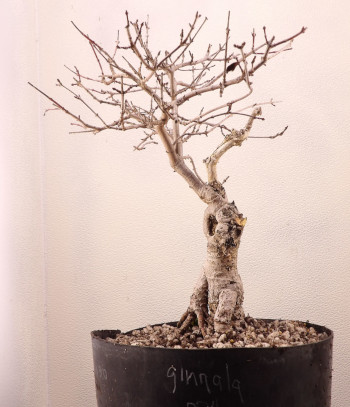 |
Acer campestre
Hedge Maple 5 inch
caliper trunk, 28 x 23 in 17 inch Anderson pot. Ready for
bonsai pot.
Tree in pot. $4000
|
|
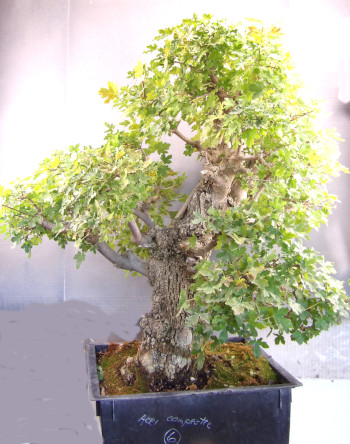 |
Acer Palmatum
Acer palmatum
0500-01,
Japanese maple seedling A 25yr + seedling grown Japanese
maple with nice nebari, thick 2 inch caliper tapered trunk and some
ramification . Ready for bonsai pot. Winter view
Tree in cut down 10 inch pot. $500 SOLD!
|
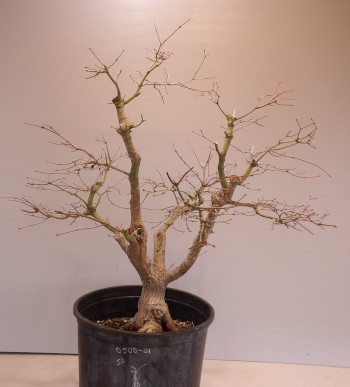 |
Acer palmatum
'Butterfly' 0535-01 A
cutting grown 'Butterfly' Japanese maple. No graft. Ready for bonsai
pot. Winter view
Tree in cut down 8 inch pot. $300 SOLD!
|
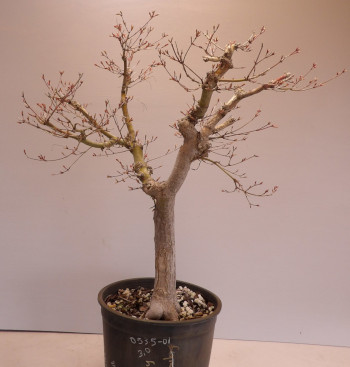 |
Acer palmatum
0500-02, Japanese Maple seedling
A seedling grown Japanese maple. An almost 2 inch caliper trunk with
an incredible taper. Nice slanting trunk movement Final branches in
place with lots of ramification. Ready for bonsai pot. Winter view
Tree in cut down 8 inch pot. $700
|
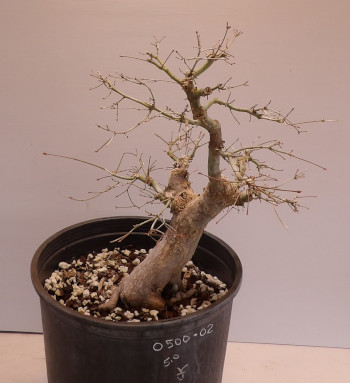 |
Acer palmatum
0500-03 Japanese Maple
seedling Seedling grown Japanese maple in one gallon pot.
15 years old, good trunk caliper, suitable for shohin. Final
branching in place with good ramification started. Ready for bonsai
pot.
Tree in pot. $400
|
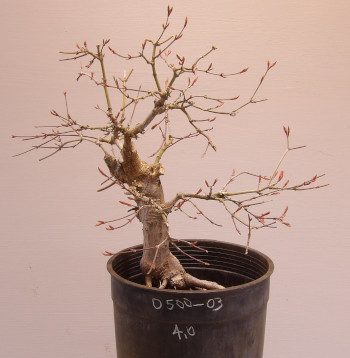 |
Acer palmatum
0500-05 Japanese Maple
seedling Seedling grown Japanese maple in one gallon pot.
15 years old, trunk caliper about 1 1/2 inches, suitable for shohin.
Final branching in place with good ramification started. Ready for
bonsai pot.
Tree in pot. $400
|
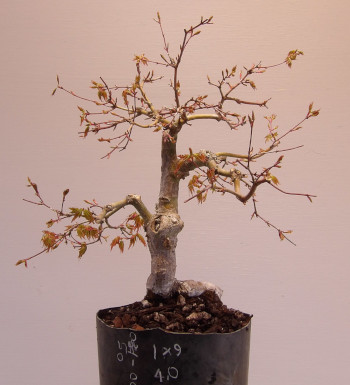 |
Acer palmatum
0502-02,
Japanese maple small leaf, small seed seedling A more
developed 25yr + seedling grown Japanese maple with nice nebari,
thick 1 1/2 inch caliper tapered trunk and excellent ramification .
Ready for bonsai pot. Winter view
Tree in cut down 10 inch pot. $700
|
 |
Acer palmatum
0502-04 Japanese Small Leaf,
Small Seed Maple A very beautiful seedling grown
Japanese maple in one gallon pot. 15 years old, good trunk caliper,
suitable for small bonsai. Final branching in place with good
ramification started. Ready for bonsai pot.
Tree in pot. $500 SOLD! |
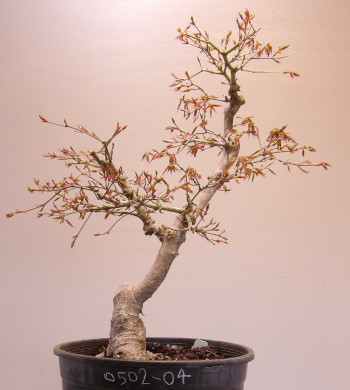 |
Acer palmatum
0508-01 'Ao Kanzashi' A cutting grown 'Ao Kanzashi'
Japanese maple. No graft. Ready for bonsai pot. Winter view
Tree in cut down 8 inch pot. $400 SOLD!
|
|
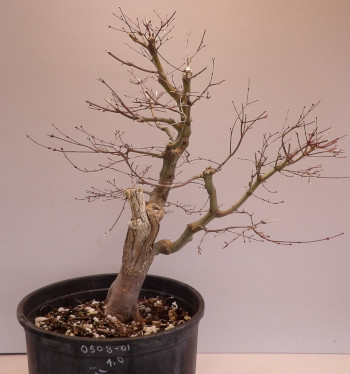 |
Acer palmatum
0508-02 'Ao Kanzashi' A cutting grown 'Ao Kanzashi'
Japanese maple. No graft. Ready for bonsai pot. Winter view
Tree in cut down 8 inch pot. $500
|
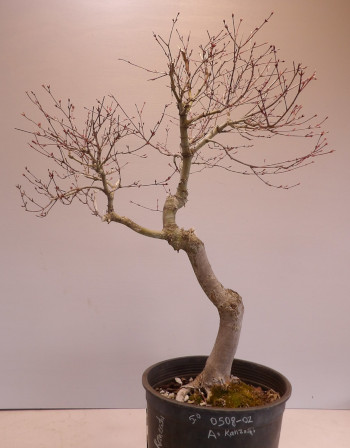 |
Acer palmatum
0749-01 'Yuri Hime' A 25+ year old cutting grown 'Yuri
Hime ' Japanese maple. No graft. Good nebari. Ready for bonsai pot.
Winter view
Tree in one gallon nursery pot $800
SOLD!
|
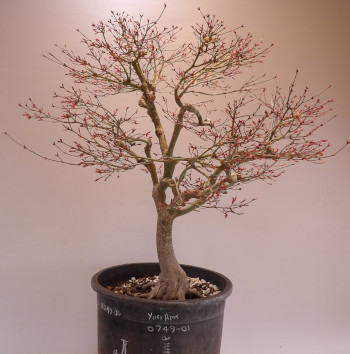 |
Buxus microphylla
'Compacta' -01 (Kingsville)
Boxwood A tiny 10 inch 30 year old Kingsville with a
neagari base, A very interesting coiled and peaked deadwood feature,
quite unusual. Potted in a six inch ceramic training pot. Winter
foliage
Tree in ceramic pot. $900
|
|
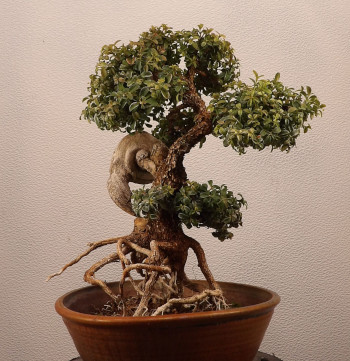 |
Chaenomeles
It is exceedingly difficult to grow specimen sized Chaenomeles,
or Flowering Quince. This shrubby species does not form a single trunk in
nature, but rather is a continuously suckering cluster of thin stems.
Growing a larger trunk requires endless removal of the suckering stems to a
select single stem or clump. Getting a one inch caliper trunk requires at
least a decade or more of growing. The following specimen are all over
twenty years old with stems approximately one inch caliper for most. The one
gallon cans are about six inches across to give you a measuring reference.
Another problem is a lack of branching and ramification. These trees below
are in the beginning stages of ramification, but with regular pinching, they
will ramify now that the trunks are finished or nearly finished. A third
problem with flowering quince is getting any kind of bark texture and
interest, even on very old stems. This problem has been solved for us by the
industrious work of voles, that have sometimes eaten large portions of the
bark, but the plants have survived and replaced the old bark with a nice
rough textured bark. Without this damage the rough bark would have never
formed. Indeed, the bark and nebari is what makes the plants below so
valuable. It is nearly impossible to find quince with good bark, nebari, and
trunk movement.
Since these are some of the oldest plants in the nursery, they have suffered
years of abuse but have survived and developed into unique trees.
Unfortunately, they have often lost their ID tags in the process. Where this
has happened, I have ventured a guess as to the identity, but I will be able
to ID them all next spring when they flower. So, if you purchase one now
without a positive ID, you will be able to have me identify it for next year
if you send me a photo. Of course this means takinga chance on flower color.
For me, this isn't a big deal on a specimen quince since it is the trunk
that is the real value here, but if flower color is the most important
characteristic for you, then please choose one with a positive ID.
To give you a sense of the rarity of these unusual specimen, I have grown
thousands of quince over the years, and of these thousands, only the handful
below have developed into trunks that I consider worthy to be called
specimen. AND there will never be any more from our nursery.
Ginkgo biloba
Ginkgo biloba
4350-01 seedling A seedling grown 25+ year old
Ginkgo. No graft. Really nice trunk movement. Over 2 inch caliper
about 2 feet tall. Good ramification for a Ginkgo. GReady for bonsai
pot. Winter view
Tree in cut down 8 inch pot. $500 SOLD!
|
|
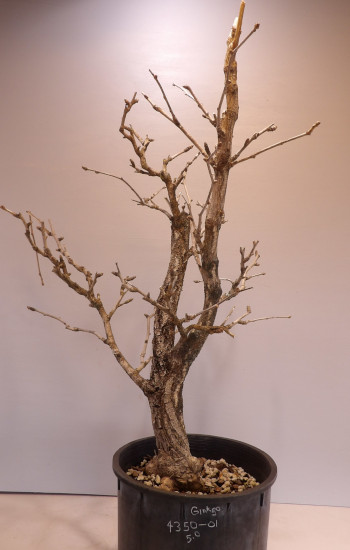 |
Liquidambar
orientalis
This oriental sweetgum is similar to our southern sweetgum, L. styraciflua
except that it's fall color is pure yellow with occasional tinges of red
and orange, the leaves are more indented and rounded, and it is better
behaved for bonsai. It still throws fat wild shoots in the spring that can
be avoided by disbudding the terminal buds as they begin to swell. It has
fantastic dark furrowed, almost black bark that matures rather quickly as
you can see from the specimen below. These specimen were grown out for
trunks, which are now finished or nearly so. They were root pruned and
repotted in squat cut off five gallon pots creating a nice shallow root
ball of about 4 inches. The branches were pruned back or removed, and now
it is time to develop ramificiation. A few will need critical branches,
but this is very easy since this species will literally explode with buds
in the spring, most of which will need to be rubbed off, but some can be
left for needed branches. This species tends to form thick roots. Wherever
possible, these have been removed, but it is very difficult to get a very
refined nebari, so don't let that weigh on your decision.
More Coming
Malus Crabapple.
Crabs make wonderful bonsai specimen. Many of our trees are one
gallon pots and destined to be shohin, which is quite a challenge give the
usually larger leaves and coarse internodes. But it can be done with
constant attention to pinching and by using the smaller cultivars such as
M. sieboldii x, M. sargentii
'Tina', M. 'Sugar Tyme', and M. 'Mary Potter. All of our cultivars
are suitable for bonsai, but may have to be used for medium to larger
bonsai. Crabs are vigorous and cold hardy trees. The flowers and fruit
make a wonderful show, and most have beautiful Fall color as well. Being
fruit trees, crabs suffer from many of the same pests and diseases as
their larger fruiting cousins. Aphids, woolly aphids, scale, and other
sucking insects are fairly easily controlled with a systemic insecticide
containing imidicloprid or disyston. They should not be sprayed with
Malathion. Winter spraying with fixed copper fungicide will control most
fungal diseases. Horticultural oils also work well.
6100-235 Malus'Donald Wyman' A very tall
graceful feminine tree with good trunk movement. .
Specimen tree in a one gallon pot $350
|
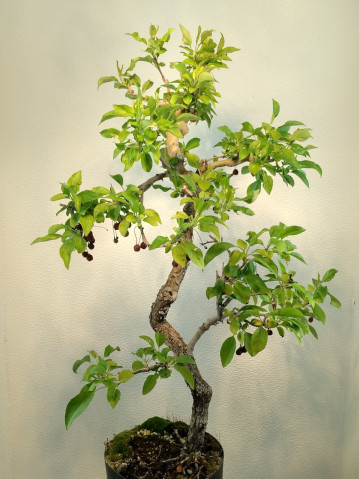 |
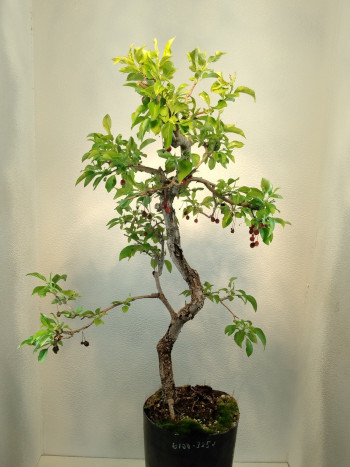 |
6100-223 Malus'Donald Wyman' Old 25 year
Specimen tree showing large 2 inch caliper stubby trunk with
mature branches and almost finished ramification. Fantastic
gnarled nebari. This tree flowers and fruits well.
Specimen tree in three gallon pot $1200
|
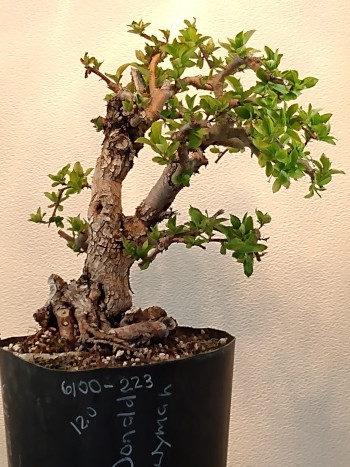 |
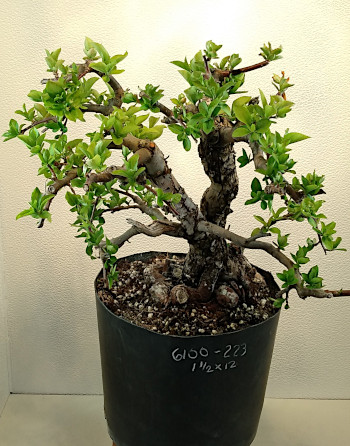 |
6130-017 Malus'Hopa' Old 1 inch trunk and
decent nebari, 18 inches tall. Good trunk movement. Plenty of
branches to work with. Deep purple new foliage color and small red
apples. Capable of decent leaf reduction and ramification as can
be seen here, but proper pruning is must.
Specimen tree in one gallon pot $300
|
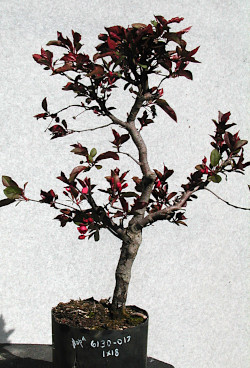 |
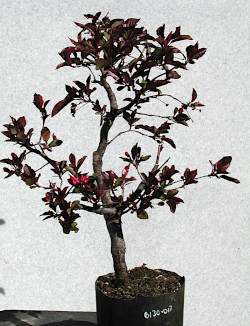 |
6200-059 Malus 'Profusion'
Red fall color and small red apples. New purple foliage and
deep pink flowers. Red summer foliage. One inch caliper, 12 inches
wide by 15 inches tall. One of the best for leaf reduction and
ramification, but proper pruning is a must.
Specimen tree in one gallon pot $400
|
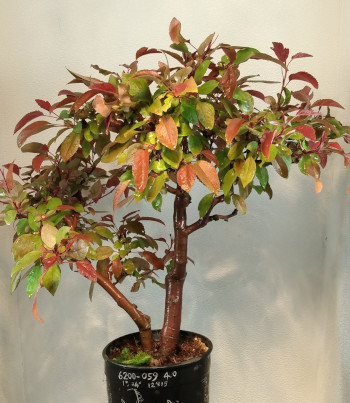 |
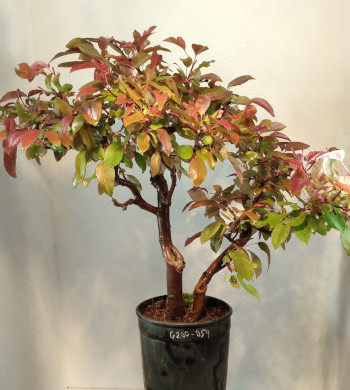 |
6200-235 Malus'Profusion' Old 1 1/2 inch
trunk, 16 inches tall, and decent nebari. Good trunk movement.
Plenty of branches to work with. Red fall color and small red
apples. New purple foliage and deep pink flowers can be seen in
photo. One of the best for leaf reduction and ramification as can
be seen here, but proper pruning is a must.
Specimen tree in one gallon pot $400 SOLD!
|
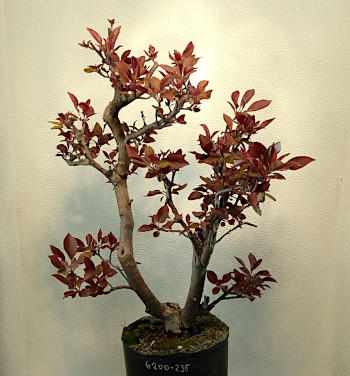 |
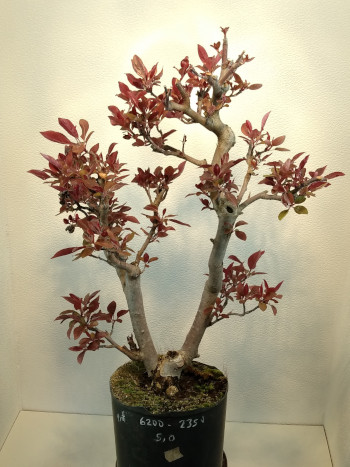 |
6220-117 Malus 'Red Jewel'
Old 1 inch trunk, 18 inches tall, and decent nebari. Good
trunk movement. Plenty of branches to work with. Green new foliage
with yellow and red fall color and small red apples. Capable of
decent leaf reduction and ramification as can be seen here, but
proper pruning is must.
Specimen tree in one gallon pot $400
|
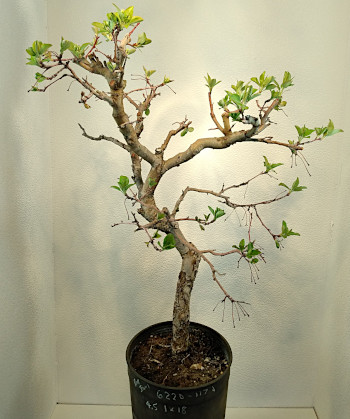 |
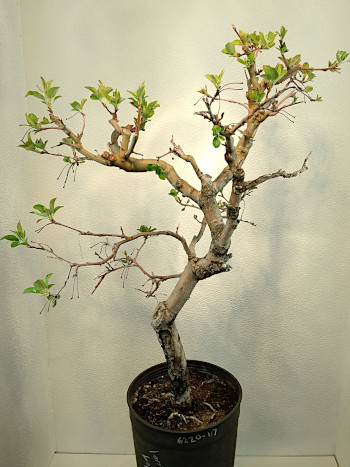 |
6572-155 Olea europaea
(Dwarf Olive) Dwarf olive with a 2 1/2 burl base. Ready for
a bonsai pot. Cutting grown from our nursery.
Specimen tree in 9 inch plastic pot $400
|
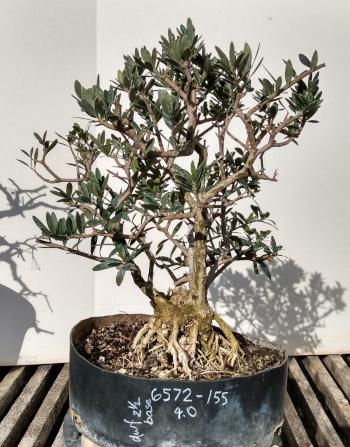 |
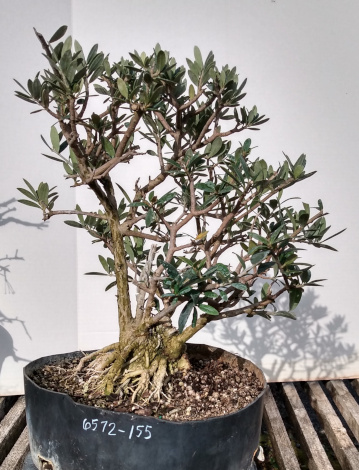 |
6572-020 Olea europaea
(Dwarf Olive) 4 inch burl base. Burl and stem styling with
very good branching and excellent ramification already. Ready for
a bonsai pot. Cutting grown from our nursery.
Specimen tree in 10 inch plastic pot $850
|
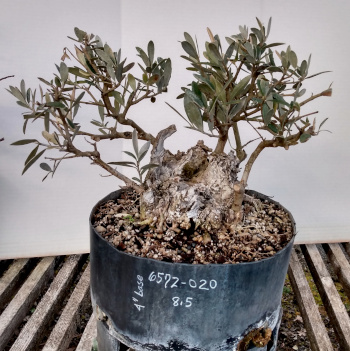 |
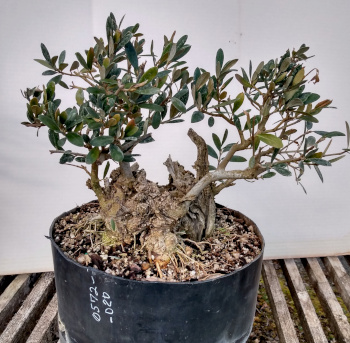 |
6572-162 Olea europaea
(Dwarf Olive) 7 inch burl base. Burl and stem styling with
very good branching and excellent ramification already. Attractive
deadwood in burl. Ready for a bonsai pot. Cutting grown from our
nursery.
Specimen tree in 10 inch plastic pot $950
|
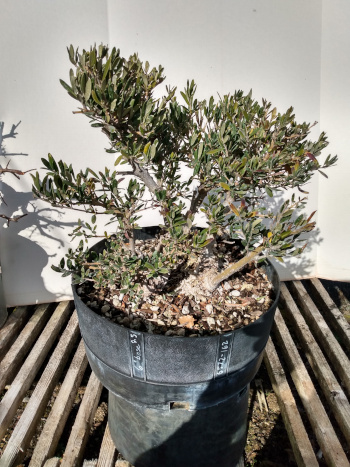 |
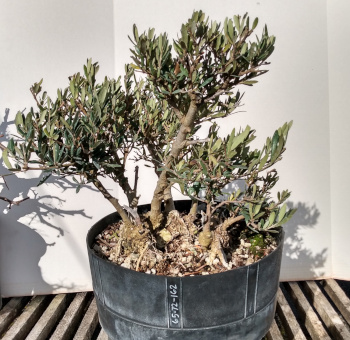 |
7950-030 Quercus agrifolia California Coast Live Oak. 2
1/4 inch caliper trunk. Several different designs possible
Tree in shortened 8 inch wide pot. $400
|
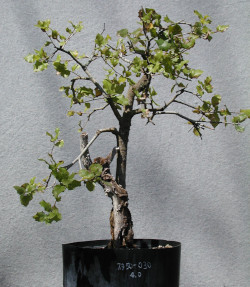 |
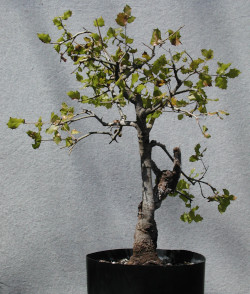 |
7950-060 Quercus agrifolia California Coast Live Oak. 2
1/4 inch caliper trunk. Another great base just waiting for a tree
to be built on it. Lower crossing branch is a sacrifice, or could
be shortened and used as a first branch on a short tree.
Tree in shortened 8 inch wide pot. $700
|
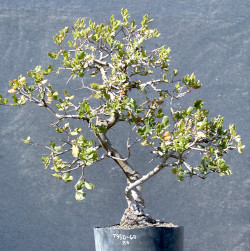 |
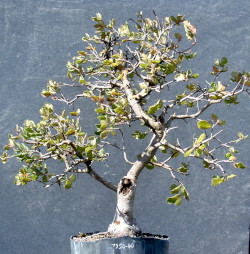 |
Tilia cordata Linden, Lime tree. 2
inch caliper trunk. Another great nebari and trunk waiting for a
tree to be built on it. Plenty of branching. Been in this pot for 15
years.
Tree in one gallon pot. $300 SOLD!
|
|
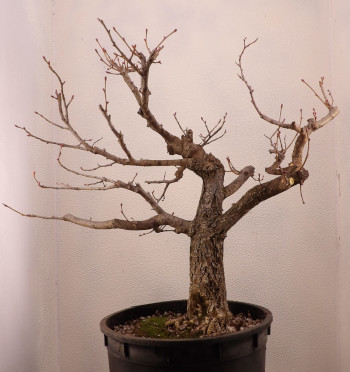 |
Ulmus
9610, 9650, 9680, Ulmus parvifolia
'Corticosa', 'Seiju', 'Yatsubusa' (Cork Bark Chinese Elms)
The following collection ofelms were started by Brent as cuttings
in the late 1980's. A few were field grown at one point, but most were
container grown by the "escape method". These are mostly trunkfinished
trees approximately 25 years old. You won't find any 'stove pipe' straight
trunks here, only well tapered four inch plus trunks with great movement
and mature bark. Nearly all the old scars are healed over and invisible.
Now it is time to begin final branch and apex formation. Most had all the
branches removed or stubbed back in 2009 and 2010, although a couple have
had more advanced branch training. All were repotted in 2011 or 2012. They
are potted in 15 inch square by 5 inch deep mesh bottom Anderson pots.
They are photographed after pruning so that you can see the whole
structure. I can honestly say that there are virtually no other trees like
these in the US. We must have payment in order to reserve them until they
are shipped. You can use the side of the pot (15 inches) to estimate the
trunk size and height. A few smaller elms will be included this year, for
those on a budget and want to grow their own trunks, or use them for
shohin and smaller size bonsai.
9600-227 Ulmus parvifolia 'Catlin' Dwarf Catlin suitable for
shohin with1 1/8 inch caliper trunk and 8 inches tall. Excellent
ramificiation. Recently repotted into an 8 inch plastic pot
Tree in shortened five gallon pot $500
|
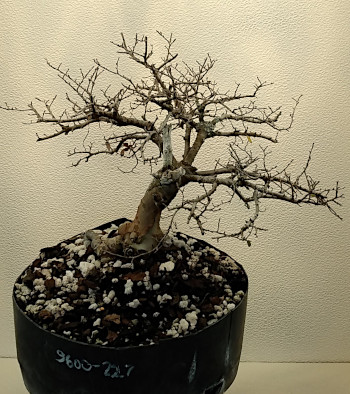 |
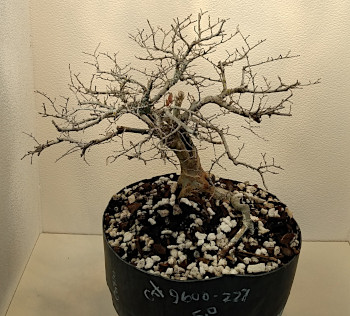 |
9650-201 Ulmus parvifolia 'Seiju' Massive trunk which you can
guage by how much of the 15 inch Anderson flat it covers.
Excellent rootage and nebari. Orange color is from recent moss
removing and cleaning of trunk. An application of lime sulfur will
restore natural matching color. This is definitely a one a kind
tree which only needs final branch work. This tree will worth two
or three times this price in a year or two.
Specimen tree $1500
|
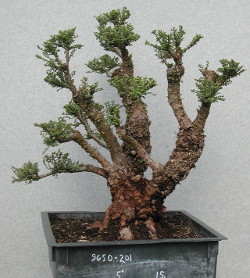 |
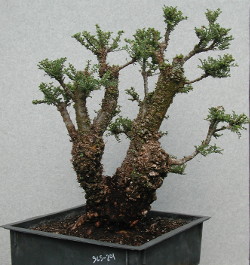 |
9680-223 Ulmus parvifolia 'Yatsubusa' 'Yatsubusa' double trunk
with 4 inch base caliper trunk with good movement. Good branching
and ramification. 10 inch shallow plastic pot.
Specimen tree $850
|
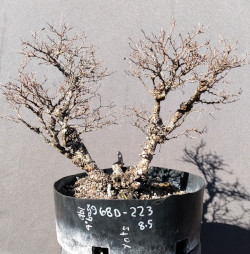 |
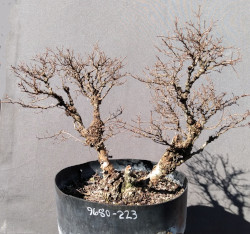 |
9975-010 Zelkova serrata A stubby zelkova that has
had the trunk shortened to create the crown from the three large
branches. Scar from the removal should be carved or left to rot
into shari. Good secondary branching already. 10 inch plastic pot.
Specimen tree $400 SOLD!
|
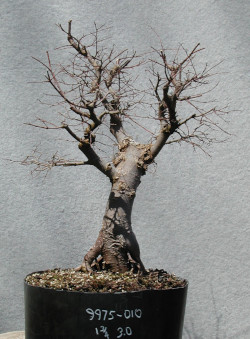 |
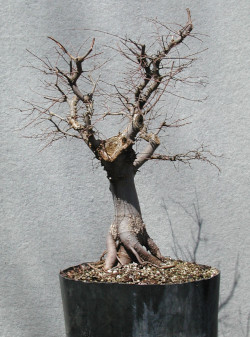 |
9975-01 Zelkova serrata A stubby zelkova that has
excellent nebari. Good primary branching. 10 inch plastic pot.
Specimen tree $300
|
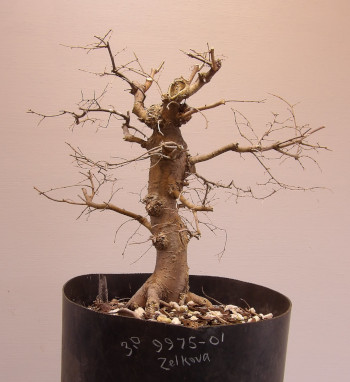 |
9975-02 Zelkova serrata A very nice zelkova that
has good trunk taper. Scar from the removal should be carved
or left to rot into shari. Final branches need a few years
work to form secondary branching and ramification. 10 inch
plastic pot.
Specimen tree $300
|
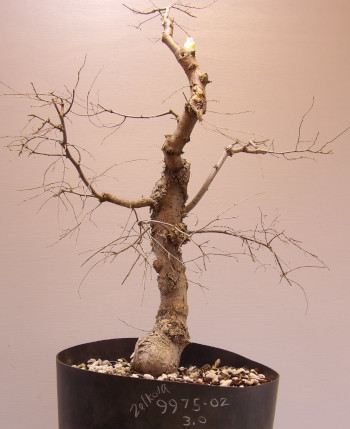 |
9975-03 Zelkova serrata Zelkova with good nebari
and decent trunk taper. Ready for branch ramification. 10 inch
plastic pot.
Specimen tree $300
|
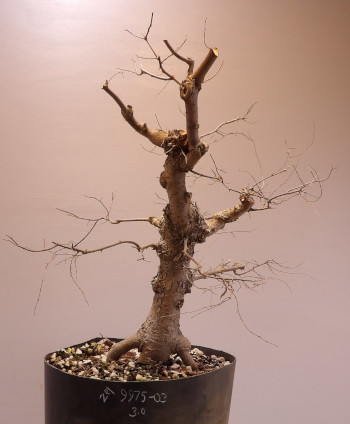 |
9975-04 Zelkova serrata A more developed Zelkova
with excellent nebari and trunk taper. Plenty of branches with
a decent amount of ramification already. 10 inch plastic
pot.
Specimen tree $500
|
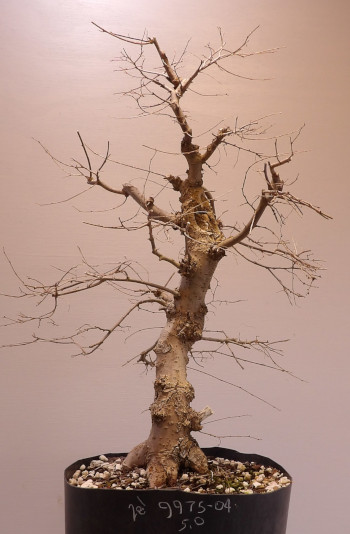 |
9975-05 Zelkova serrata A nice upright Zelkova
with good trunk taper and swollen base. Final branches in
place just needs a few years of ramification. 10 inch plastic
pot.
Specimen tree $500
|
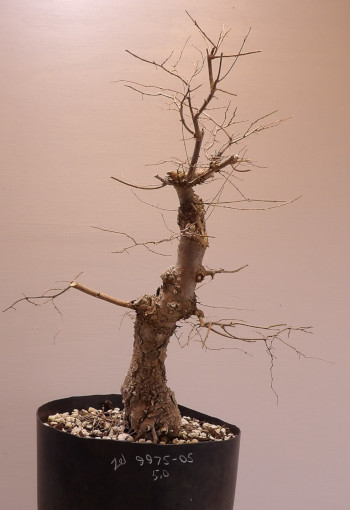 |
9975-06 Zelkova serrata A double header Zelkova.
Either the left or the right trunks could be removed depending
if you want a good upright, or a more moving trunk. Or you
could just keep both of them! Really nice nebari. Good
branching and ramification already. 10 inch plastic pot.
Specimen tree $700
|
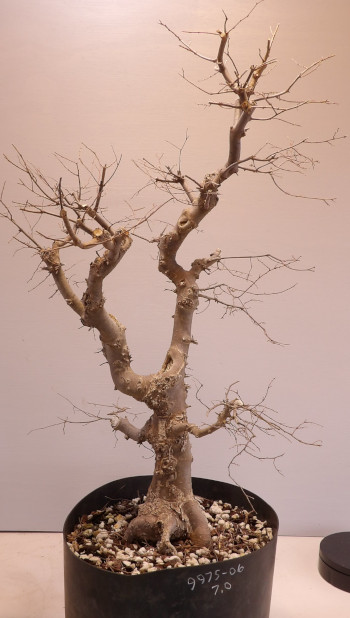 |
9975-07 Zelkova serrata A more developed
Zelkova. More branches than you really need. Good secondary
branching and excellent amount of ramification already. Really
nice buttress and nebari. 10 inch plastic pot.
Specimen tree $1200
|
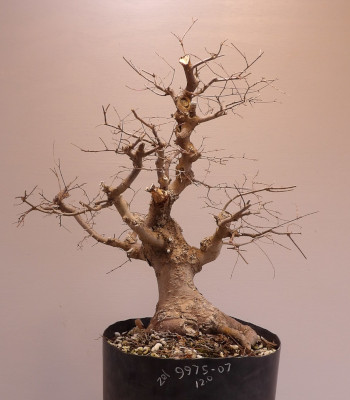 |
9975-08 Zelkova serrata A more developed Zelkova
trunk. Good taper and a wide nebari. 10 inch plastic pot.
Specimen tree $1100
|
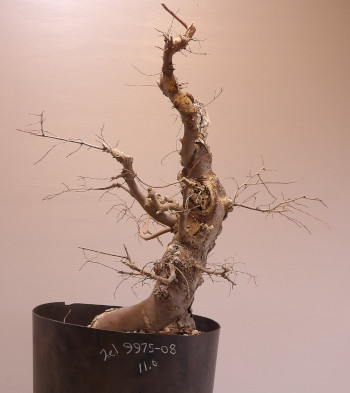 |
9975-09 Zelkova serrata A more developed Zelkova. More
branches than you really need. Good taper and secondary branching,
excellent amount of ramification already. Really big buttress and
nebari. 10 inch plastic pot.
Specimen tree $1200
|
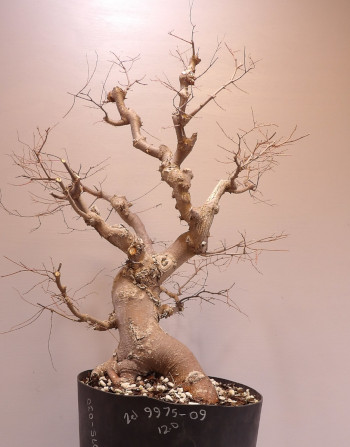 |
9975-10 Zelkova serrata A more developed Zelkova. More
branches than you really need. Good secondary branching and
excellent amount of ramification already. Really nice buttress and
nebari. 10 inch plastic pot.
Specimen tree $1200
|
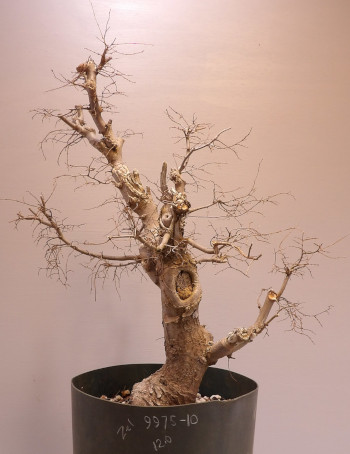 |
9975-11 Zelkova serrata A more developed Zelkova. More
branches than you really need. Good secondary branching and
excellent amount of ramification already. Really nice buttress and
nebari. 10 inch plastic pot.
Specimen tree $1200
|
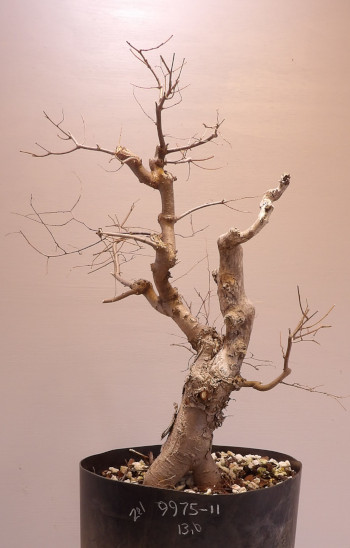 |
9975-12 Zelkova serrata A more developed Zelkova. Good
trunk, needs more branch work. Good nebari. 10 inch plastic pot.
Specimen tree $900
|
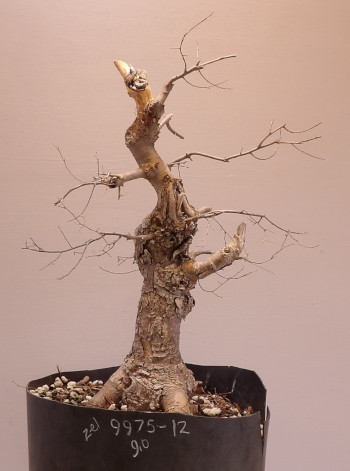 |
9975-13 Zelkova serrata A more tall Zelkova. Could be
shortened at several places depending on the height of the tree
desired. 10 inch plastic pot.
Specimen tree $900
|
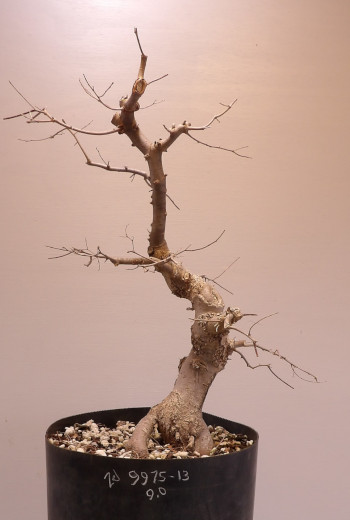 |
9975-14 Zelkova serrata A more developed Zelkova. More
branches than you really need. Good secondary branching and
excellent amount of ramification already. Really nice buttress. 10
inch plastic pot.
Specimen tree $900
|
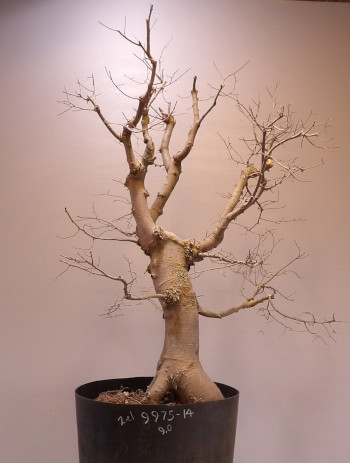 |
9975-15 Zelkova serrata A smaller Zelkova. Deadwood
shari. Big buttress and moving trunk. 10 inch plastic pot.
Specimen tree $400 SOLD!
|
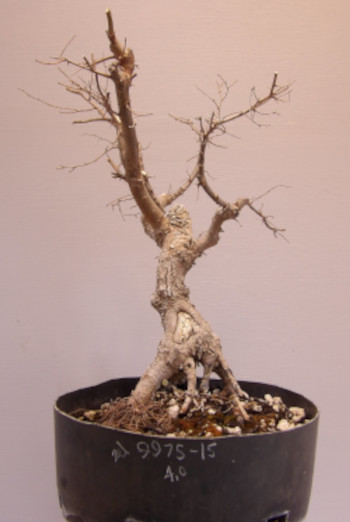 |
9975-16 Zelkova serrata A more developed Zelkova. More
branches than you really need. Good secondary branching and
excellent amount of ramification already. Nice buttress and tapered
trunk. 10 inch plastic pot.
Specimen tree $1000
|
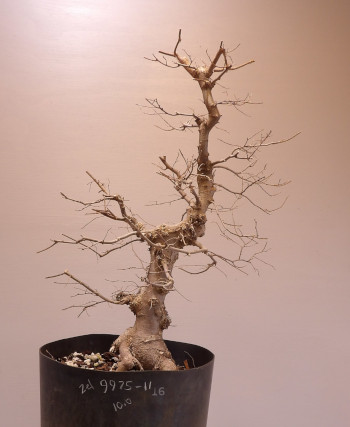 |
9990-120 Zelkova carpinifolia
A shorter carpinifolia that could make a very striking
shohin, 1 1/2 caliper, 12 inches tall. Broad base, plenty of
branches to work with, irregular trunk adds interest in a small
bonsai. 3 gallon plastic pot.
Specimen tree $600
|
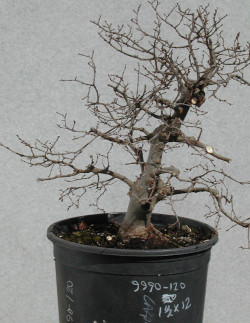 |
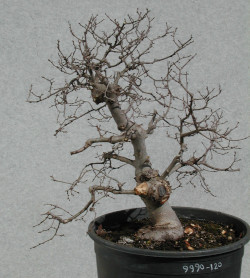 |
/html>





















